Frank Drake, astronomer, dies
 Astronomer Dr. Frank Drake, one of the founders of SETI (the Search for Extra-Terrestrial Intelligences), dies at the age of 92. His fascinating with searching for life on other worlds began at a young age, and defined much of his life and career. In the 1960s, as part of a lecture, he devised the Drake Equation, a formula for calculating a very rough estimate of the possible number of civilizations capable of communicating across interstellar distances; this equation has been debated and challenged over the years, as well as gaining mainstream recognition after being cited in popular science programming (such as Carl Sagan’s Cosmos) and science fiction as well. In the 1970s, Drake and Sagan joined forces to create the “messages in bottles” affixed to the earliest space probes expected to break free of the solar system, including the Pioneer plaques and the golden records attached to Voyagers 1 and 2.
Astronomer Dr. Frank Drake, one of the founders of SETI (the Search for Extra-Terrestrial Intelligences), dies at the age of 92. His fascinating with searching for life on other worlds began at a young age, and defined much of his life and career. In the 1960s, as part of a lecture, he devised the Drake Equation, a formula for calculating a very rough estimate of the possible number of civilizations capable of communicating across interstellar distances; this equation has been debated and challenged over the years, as well as gaining mainstream recognition after being cited in popular science programming (such as Carl Sagan’s Cosmos) and science fiction as well. In the 1970s, Drake and Sagan joined forces to create the “messages in bottles” affixed to the earliest space probes expected to break free of the solar system, including the Pioneer plaques and the golden records attached to Voyagers 1 and 2.
James Webb Space Telescope launched
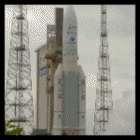 After well over a decade of development (and setbacks as the project fell in and out of favor with successive administrations of the U.S. government), the international James Webb Space Telescope is launched aboard an Ariane V rocket from the European Space Agency’s Kourou Space Center in French Guiana. Constructed and operated by NASA, the Webb Space Telescope is the larger successor to the Hubble Space Telescope, and its intricate, origami-like construction is expected to take a full month to deploy as the telescope travels to the L2 LaGrange point, well beyond the orbit of the moon. Its multi-segmented mirror is expected to see much more distant objects than Hubble was capable of resolving, possibly including the first galaxies to form in the history of the universe.
After well over a decade of development (and setbacks as the project fell in and out of favor with successive administrations of the U.S. government), the international James Webb Space Telescope is launched aboard an Ariane V rocket from the European Space Agency’s Kourou Space Center in French Guiana. Constructed and operated by NASA, the Webb Space Telescope is the larger successor to the Hubble Space Telescope, and its intricate, origami-like construction is expected to take a full month to deploy as the telescope travels to the L2 LaGrange point, well beyond the orbit of the moon. Its multi-segmented mirror is expected to see much more distant objects than Hubble was capable of resolving, possibly including the first galaxies to form in the history of the universe.
Charging the view of distant atmospheres
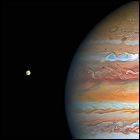 NASA and ESA announce that spectrographic analysis of Hubble Space Telescope data gathered during observations of Jupiter’s icy moon Europa reveals that Europa has a persistent atmosphere of water vapor, but only on the hemisphere of the moon that is opposite of the direction of its orbital motion. (This unusual effect had been predicted in computer modeling, but had not been directly observed until now.) The atmosphere is present in Hubble spectroscopy data as old as 1999 and as recent as 2015. The stability of the water vapor in the atmosphere is the real surprise find, since surface-based water was assumed to be in solid ice form.
NASA and ESA announce that spectrographic analysis of Hubble Space Telescope data gathered during observations of Jupiter’s icy moon Europa reveals that Europa has a persistent atmosphere of water vapor, but only on the hemisphere of the moon that is opposite of the direction of its orbital motion. (This unusual effect had been predicted in computer modeling, but had not been directly observed until now.) The atmosphere is present in Hubble spectroscopy data as old as 1999 and as recent as 2015. The stability of the water vapor in the atmosphere is the real surprise find, since surface-based water was assumed to be in solid ice form.
Arecibo Radio Telescope collapses
 The 57-year-old Arecibo Radio Telescope is destroyed when its 900-ton equipment platform, suspended over the massive dish built into a geographic feature near Arecibo, Puerto Rico, falls into the dish, causing catastrophic damage to both. The platform had been suspended by miles of steel cables from three towers over the dish, through a recent assessment of the ability of both cables and towers to bear the platform’s load had raised doubts that the facility could remain operational. As the decision had already been made to decommission and dismantle the Arecibo telescope, the facility had already been evacuated prior to the collapse. The towers holding the platform over the dish also suffer severe damage, rendering them structurally unsafe as well. Locals compared the sound of the event to that of an avalanche or an earthquake.
The 57-year-old Arecibo Radio Telescope is destroyed when its 900-ton equipment platform, suspended over the massive dish built into a geographic feature near Arecibo, Puerto Rico, falls into the dish, causing catastrophic damage to both. The platform had been suspended by miles of steel cables from three towers over the dish, through a recent assessment of the ability of both cables and towers to bear the platform’s load had raised doubts that the facility could remain operational. As the decision had already been made to decommission and dismantle the Arecibo telescope, the facility had already been evacuated prior to the collapse. The towers holding the platform over the dish also suffer severe damage, rendering them structurally unsafe as well. Locals compared the sound of the event to that of an avalanche or an earthquake.
Arecibo Observatory slated for demolition
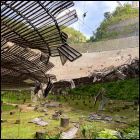 After being in operation for most of the past 57 years, the fate of the Arecibo Radio Telescope facility is sealed by the failure of two major tension cables suspending the 900-ton equipment platform over the dish carved into the Puerto Rican countryside. Engineering safety assessments reveal that other cables are on the verge of failure, which could lead to an “uncontrolled collapse” putting the lives of nearby researchers and engineers at risk. As a result, the Arecibo facility – originally a project of Cornell University but now managed by the University of Central Florida – is slated for demolition as soon as is safely possible, provided its aging superstructure doesn’t collapse under its own weight first. The observatory’s physical superstructure had been under close observation since suffering major damage from Hurricane Maria, which caused widespread destruction in Puerto Rico in 2017. The closure of the Arecibo facility marks the end of a significant era of radio astronomy.
After being in operation for most of the past 57 years, the fate of the Arecibo Radio Telescope facility is sealed by the failure of two major tension cables suspending the 900-ton equipment platform over the dish carved into the Puerto Rican countryside. Engineering safety assessments reveal that other cables are on the verge of failure, which could lead to an “uncontrolled collapse” putting the lives of nearby researchers and engineers at risk. As a result, the Arecibo facility – originally a project of Cornell University but now managed by the University of Central Florida – is slated for demolition as soon as is safely possible, provided its aging superstructure doesn’t collapse under its own weight first. The observatory’s physical superstructure had been under close observation since suffering major damage from Hurricane Maria, which caused widespread destruction in Puerto Rico in 2017. The closure of the Arecibo facility marks the end of a significant era of radio astronomy.
Professor Stephen Hawking, physicist, dies
 Widely regarded as one of the 20th and 21st centuries’ finest minds in the fields of theoretical physics and cosmology, Professor Stephen Hawking dies at the age of 76, having suffered from ALS (better known as Lou Gehrig’s Disease) for over 50 years. He far outlived the few years he was expected to live when he was diagnosed in 1963. In that time, he co-authored a 1970 paper which referred back to Einstein’s Theory of General Relativity to lend great credibility to the then-new (and not widely accepted) theory of the universe’s origins in a “big bang”. Later that same year he began working on research that would eventually lead to the theory that black holes would emit a signature radiation, dubbed Hawking radiation, though those emissions had yet to be observed directly at the time of Hawking’s death. His best-selling 1988 book, “A Brief History Of Time”, propelled Hawking (and his remarkable survival story) into the public eye, though by this time he was wheelchair-bound and reliant on a speech synthesizer to communicate with others.
Widely regarded as one of the 20th and 21st centuries’ finest minds in the fields of theoretical physics and cosmology, Professor Stephen Hawking dies at the age of 76, having suffered from ALS (better known as Lou Gehrig’s Disease) for over 50 years. He far outlived the few years he was expected to live when he was diagnosed in 1963. In that time, he co-authored a 1970 paper which referred back to Einstein’s Theory of General Relativity to lend great credibility to the then-new (and not widely accepted) theory of the universe’s origins in a “big bang”. Later that same year he began working on research that would eventually lead to the theory that black holes would emit a signature radiation, dubbed Hawking radiation, though those emissions had yet to be observed directly at the time of Hawking’s death. His best-selling 1988 book, “A Brief History Of Time”, propelled Hawking (and his remarkable survival story) into the public eye, though by this time he was wheelchair-bound and reliant on a speech synthesizer to communicate with others.
The seven worlds of TRAPPIST-1
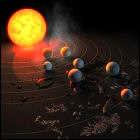 NASA announces the discovery, via the Spitzer Space Telescope, of a system of seven Earth-sized worlds orbiting the star TRAPPIST-1, only 40 light years from Earth’s solar system. Though water may exist in some state on all seven of the planets, three of them are thought to be orbiting within the “Goldilocks zone” in which liquid water would be abundant, making life possible on the surfaces of those planets.
NASA announces the discovery, via the Spitzer Space Telescope, of a system of seven Earth-sized worlds orbiting the star TRAPPIST-1, only 40 light years from Earth’s solar system. Though water may exist in some state on all seven of the planets, three of them are thought to be orbiting within the “Goldilocks zone” in which liquid water would be abundant, making life possible on the surfaces of those planets.
Vera Rubin, astronomer, dies
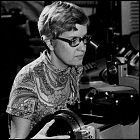 Pioneering astronomer Vera Rubin, whose research led to the discovery of dark matter, dies at the age of 88. In the 1960s and ’70s, Rubin found that the rate of galaxies’ rotation could not be accounted for unless galaxies contained, on average, ten times more mass than could be distributed among the visible stars in that galaxy. This research led her to propose the theory of dark matter in the 1970s, though she tried for many years to find – or at least rule out – any other possible explanations to the galaxy rotation problem.
Pioneering astronomer Vera Rubin, whose research led to the discovery of dark matter, dies at the age of 88. In the 1960s and ’70s, Rubin found that the rate of galaxies’ rotation could not be accounted for unless galaxies contained, on average, ten times more mass than could be distributed among the visible stars in that galaxy. This research led her to propose the theory of dark matter in the 1970s, though she tried for many years to find – or at least rule out – any other possible explanations to the galaxy rotation problem.
The new and improved Great Dark Spot
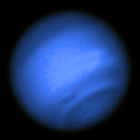 NASA’s Hubble Space Telescope confirms the observations of Earthbound astronomers with high-powered telescopes: a new dark atmospheric feature has emerged on the planet Neptune, signifying a major new storm system in the planet’s atmosphere. The new vortex feature emerges near the south polar area of Neptune, and was first observed by telescope in 2015.
NASA’s Hubble Space Telescope confirms the observations of Earthbound astronomers with high-powered telescopes: a new dark atmospheric feature has emerged on the planet Neptune, signifying a major new storm system in the planet’s atmosphere. The new vortex feature emerges near the south polar area of Neptune, and was first observed by telescope in 2015.
Hitomi lost
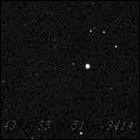 JAXA, the Japanese Space Agency, declares the Hitomi X-ray astronomy satellite a total loss, having lost all contact with it. Though the diagnosis of the evidence to date is ongoing, engineers conclude from the available data that Hitomi entered an uncontrolled spin and broke up in orbit. JAXA offers apologies not only to other countries’ space agencies who supplied equipment for Hitomi, as well as to astronomers who had hoped to use the satellite.
JAXA, the Japanese Space Agency, declares the Hitomi X-ray astronomy satellite a total loss, having lost all contact with it. Though the diagnosis of the evidence to date is ongoing, engineers conclude from the available data that Hitomi entered an uncontrolled spin and broke up in orbit. JAXA offers apologies not only to other countries’ space agencies who supplied equipment for Hitomi, as well as to astronomers who had hoped to use the satellite.
The moon of Makemake
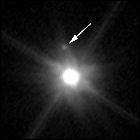 Astronomers reveal that Makemake, an icy dwarf planet orbiting in the distant Kuiper Belt region of the solar system, has a moon, first spotted in 2015 by a team using the Hubble Space Telescope. (The news comes just days after the 26th anniversary of Hubble’s launch.) With an estimated diameter of 100 miles (compared to the 870 mile diameter of its parent body), the satellite orbits Makemake at a distance of 13,000 miles, taking twelve days to complete one orbit. Previous observations failed to pick up on the dark, dim body due to the relatively bright glare of Makemake itself.
Astronomers reveal that Makemake, an icy dwarf planet orbiting in the distant Kuiper Belt region of the solar system, has a moon, first spotted in 2015 by a team using the Hubble Space Telescope. (The news comes just days after the 26th anniversary of Hubble’s launch.) With an estimated diameter of 100 miles (compared to the 870 mile diameter of its parent body), the satellite orbits Makemake at a distance of 13,000 miles, taking twelve days to complete one orbit. Previous observations failed to pick up on the dark, dim body due to the relatively bright glare of Makemake itself.
Hitomi breaks contact
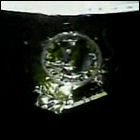 Japan’s Hitomi satellite, launched in February on a three-year X-ray astronomy mission, suddenly breaks contact with JAXA ground controllers when they begin power-up and checkout procedures. Only brief telemetry signals are received from Hitomi before it falls silent. JAXA initiates emergency procedures to contact Hitomi and diagnose the problem, though some telescopic observations from Earth indicate that pieces of the spacecraft have fallen away from the spacecraft itself.
Japan’s Hitomi satellite, launched in February on a three-year X-ray astronomy mission, suddenly breaks contact with JAXA ground controllers when they begin power-up and checkout procedures. Only brief telemetry signals are received from Hitomi before it falls silent. JAXA initiates emergency procedures to contact Hitomi and diagnose the problem, though some telescopic observations from Earth indicate that pieces of the spacecraft have fallen away from the spacecraft itself.
ASTRO-H / Hitomi
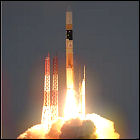 JAXA, the Japanese Space Agency, launches the ASTRO-H X-ray observatory satellite, nicknamed Hitomi, from Tanegashima Space Center. Carrying equipment provided by NASA and the Canadian Space Agency, Hitomi is intended to remain operational for three years, conducting X-ray astronomy from low Earth orbit. Though the launch proceeds without apparent problems, major technical issues will prevent Hitomi from fulfilling its mission objectives.
JAXA, the Japanese Space Agency, launches the ASTRO-H X-ray observatory satellite, nicknamed Hitomi, from Tanegashima Space Center. Carrying equipment provided by NASA and the Canadian Space Agency, Hitomi is intended to remain operational for three years, conducting X-ray astronomy from low Earth orbit. Though the launch proceeds without apparent problems, major technical issues will prevent Hitomi from fulfilling its mission objectives.
A 90% chance of iron rain
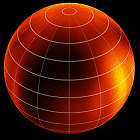 A team of scientists publishes a report in the journal Nature revealing that, using Doppler observations, they have achieved a very basic map of the “weather” patterns on the dim brown dwarf star Luhman 16B, discovered in 2013 at a distance of only 6.5 light years from Earth’s solar system. The observations reveal that the high temperature is likely to be 2,000 degrees Fahrenheit, with a very good chance of violent storms raining molten iron onto Luhman 16B’s surface in the forecast.
A team of scientists publishes a report in the journal Nature revealing that, using Doppler observations, they have achieved a very basic map of the “weather” patterns on the dim brown dwarf star Luhman 16B, discovered in 2013 at a distance of only 6.5 light years from Earth’s solar system. The observations reveal that the high temperature is likely to be 2,000 degrees Fahrenheit, with a very good chance of violent storms raining molten iron onto Luhman 16B’s surface in the forecast.
Mega-eruption on Io
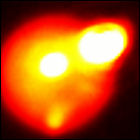 Astronomers using the Keck Observatory’s Hawaii-based telescopes and near-infrared cameras capture an image of a devastating volcanic eruption on Io, one of Jupiter’s largest moons (and known since 1979 to be very volcanically active). The eruption, unleashing enough molten material to reshape hundreds of square miles of Io’s surface, also reveals that the material erupted is hotter than any eruption in Earth’s recorded history. This is the most violent eruption seen to date in the solar system, and caps off two weeks of intense activity observed by the astronomers.
Astronomers using the Keck Observatory’s Hawaii-based telescopes and near-infrared cameras capture an image of a devastating volcanic eruption on Io, one of Jupiter’s largest moons (and known since 1979 to be very volcanically active). The eruption, unleashing enough molten material to reshape hundreds of square miles of Io’s surface, also reveals that the material erupted is hotter than any eruption in Earth’s recorded history. This is the most violent eruption seen to date in the solar system, and caps off two weeks of intense activity observed by the astronomers.
The raining shards of the blue planet
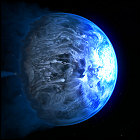 Scientists, analyzing Hubble Space Telescope spectographic data taken during a transit of the exoplanet HD 189733b against its parent star, reveal that they have determined the planet’s color in visible light. The doomed gas giant, only 63 light years away, is said to be a “deep azure blue” not unlike how Earth’s oceans appear from space, though in this case the color is theorized to be the result not of water, but of silicate rain – airborne glass – blowing in 7,000mph winds as the atmosphere is blasted away due to the planet’s proximity to its sun.
Scientists, analyzing Hubble Space Telescope spectographic data taken during a transit of the exoplanet HD 189733b against its parent star, reveal that they have determined the planet’s color in visible light. The doomed gas giant, only 63 light years away, is said to be a “deep azure blue” not unlike how Earth’s oceans appear from space, though in this case the color is theorized to be the result not of water, but of silicate rain – airborne glass – blowing in 7,000mph winds as the atmosphere is blasted away due to the planet’s proximity to its sun.
Pluto’s fourth and fifth moons named
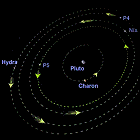 Two tiny, recently-discovered satellites of dwarf planet Pluto have new named ratified by the International Astronomical Union; P4 is renamed Kerberos and P5 is renamed Styx. The names – related to the “underworld” theme that has governed the naming of Pluto and its moons to date – overlooks a popular online vote that suggested one of the moons should be named Vulcan, after Mr. Spock’s home planet in Star Trek. Kerberos, discoverd in 2011, is believed to be approximately 20 miles in diameter and orbits Pluto at a distance of roughly 37,000 miles. Styx, first sighted in 2012, is even smaller, with an estimated diameter of 15 miles, orbiting only 1,200 miles from Pluto, making it the innermost satellite (a distinction previously held by Pluto’s near-twin, Charon). NASA’s New Horizons spacecraft will have the opportunity to see the new moons up close when it does a flyby of Pluto in 2015.
Two tiny, recently-discovered satellites of dwarf planet Pluto have new named ratified by the International Astronomical Union; P4 is renamed Kerberos and P5 is renamed Styx. The names – related to the “underworld” theme that has governed the naming of Pluto and its moons to date – overlooks a popular online vote that suggested one of the moons should be named Vulcan, after Mr. Spock’s home planet in Star Trek. Kerberos, discoverd in 2011, is believed to be approximately 20 miles in diameter and orbits Pluto at a distance of roughly 37,000 miles. Styx, first sighted in 2012, is even smaller, with an estimated diameter of 15 miles, orbiting only 1,200 miles from Pluto, making it the innermost satellite (a distinction previously held by Pluto’s near-twin, Charon). NASA’s New Horizons spacecraft will have the opportunity to see the new moons up close when it does a flyby of Pluto in 2015.
Hubble spots a Space Invader
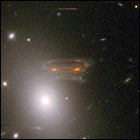 To allay public fears that the next level might not be reached, NASA offers an explanation for an enigmatic 2010 image from the Hubble Space Telescope, showing a galaxy cluster, Abell 68, approximately 2,000,000,000 light years away. In the middle of that cluster, however, is what appears to be an alien from the video game Space Invaders. NASA explains that it’s a visual artifact of gravitational lensing caused by the gravity influence of the foreground galaxies upon the light of galaxies further away in the image. Earth breathes easy once more.
To allay public fears that the next level might not be reached, NASA offers an explanation for an enigmatic 2010 image from the Hubble Space Telescope, showing a galaxy cluster, Abell 68, approximately 2,000,000,000 light years away. In the middle of that cluster, however, is what appears to be an alien from the video game Space Invaders. NASA explains that it’s a visual artifact of gravitational lensing caused by the gravity influence of the foreground galaxies upon the light of galaxies further away in the image. Earth breathes easy once more.
2012 DA14’s close shave
 One of the closest asteroid encounters since the beginning of intensive asteroid tracking, asteroid 2012 DA14 swings past Earth at a distance of only 17,200 miles – putting it closer to Earth than most weather and communcations satellites in geosynchronous orbit. Despite this, the asteroid is well outside the orbit of such low-Earth-orbit structures as the International Space Station. Discovered in February 2012, 2012 DA14 has a diameter of approximately 150 feet and is moving at a speed of over 17,000 miles per hour. 2012 DA14’s next closest approach will take place in 2046, but it will not make another passage this close until 2110. The asteroid is unrelated to a meteor airburst event earlier the same day over Russia.
One of the closest asteroid encounters since the beginning of intensive asteroid tracking, asteroid 2012 DA14 swings past Earth at a distance of only 17,200 miles – putting it closer to Earth than most weather and communcations satellites in geosynchronous orbit. Despite this, the asteroid is well outside the orbit of such low-Earth-orbit structures as the International Space Station. Discovered in February 2012, 2012 DA14 has a diameter of approximately 150 feet and is moving at a speed of over 17,000 miles per hour. 2012 DA14’s next closest approach will take place in 2046, but it will not make another passage this close until 2110. The asteroid is unrelated to a meteor airburst event earlier the same day over Russia.
Another near-miss for Russia
 In broad daylight over Chelyabinsk, Russia, a meteor likely less than ten feet in diameter unexpectedly appears in the sky and explodes in mid-air. The resulting sonic boom and shockwave break hundreds of windows, causing several hundred minor injuries and collapsing part of a building. Unsettlingly, the meteor is confirmed to be completely unrelated to the much-anticipated asteroid 2012 DA14, which is over 16 hours away from its closest approach to Earth.
In broad daylight over Chelyabinsk, Russia, a meteor likely less than ten feet in diameter unexpectedly appears in the sky and explodes in mid-air. The resulting sonic boom and shockwave break hundreds of windows, causing several hundred minor injuries and collapsing part of a building. Unsettlingly, the meteor is confirmed to be completely unrelated to the much-anticipated asteroid 2012 DA14, which is over 16 hours away from its closest approach to Earth.
NASA will launch huge solar sail in 2014
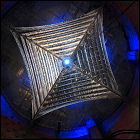 NASA announces plans to launch an experimental uncrewed test vehicle called Sunjammer into orbit in 2014, as a test of solar sail technology. Though not the first solar sail ever launched, Sunjammer be will the largest by far, its mainsail being incredibly thin Kapton with a surface area of 13,000 feet. The objective of the flight is to unfurl the sail and then use the solar wind to propel it to the L1 Earth-Sun LaGrange point nearly 2,000,000 miles from Earth. Sunjammer will be lifted into orbit by a SpaceX rocket in 2014, with both NASA and NOAA keeping a close eye on the results.
NASA announces plans to launch an experimental uncrewed test vehicle called Sunjammer into orbit in 2014, as a test of solar sail technology. Though not the first solar sail ever launched, Sunjammer be will the largest by far, its mainsail being incredibly thin Kapton with a surface area of 13,000 feet. The objective of the flight is to unfurl the sail and then use the solar wind to propel it to the L1 Earth-Sun LaGrange point nearly 2,000,000 miles from Earth. Sunjammer will be lifted into orbit by a SpaceX rocket in 2014, with both NASA and NOAA keeping a close eye on the results.
A Deep look into Comet ISON
 NASA’s Deep Impact probe, already a veteran explorer of comets, turns its camera eye toward Comet ISON, a recently-discovered comet expected to put on a spectacular show even to the naked eye in late 2013. Originally launched in 1995 to study Comet Tempel 1 at close range, Deep Impact has since used its cameras to study other comets passing through the solar system. The distance between Deep Impact and Comet ISON at the time the 36-hour photo sequence is taken is roughly 493 million miles.
NASA’s Deep Impact probe, already a veteran explorer of comets, turns its camera eye toward Comet ISON, a recently-discovered comet expected to put on a spectacular show even to the naked eye in late 2013. Originally launched in 1995 to study Comet Tempel 1 at close range, Deep Impact has since used its cameras to study other comets passing through the solar system. The distance between Deep Impact and Comet ISON at the time the 36-hour photo sequence is taken is roughly 493 million miles.
SOFIA spots a black hole
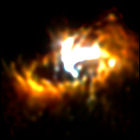 NASA reveals that its Boeing-747-mounted SOFIA (Stratospheric Observatory for Infrared Astronomy) telescope, during a 2011 flight in which its sensitive infrared sensors were aimed at the center of the Milky Way galaxy, captured an image of the super-massive black hole at the heart of the galaxy. A disc of dust and gas circling the center of the galaxy – seven light years across – lights up the image. The black hole is believed to have a mass of over four million times that of Earth’s sun.
NASA reveals that its Boeing-747-mounted SOFIA (Stratospheric Observatory for Infrared Astronomy) telescope, during a 2011 flight in which its sensitive infrared sensors were aimed at the center of the Milky Way galaxy, captured an image of the super-massive black hole at the heart of the galaxy. A disc of dust and gas circling the center of the galaxy – seven light years across – lights up the image. The black hole is believed to have a mass of over four million times that of Earth’s sun.
Radiation Belt Storm Probes find new belt
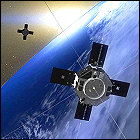 The Radiation Belt Storm Probes mission launched by NASA begins activating sensors just a few days after liftoff, weeks ahead of schedule, just in time to reveal a finding that forces a rethink of over half a century of widely-accepted science. The probes find that, in response to the recent eruption of a solar prominence, the two Van Allen radiation belts discovered in 1958 by Explorer 1 have expanded to include a third belt, which traps and repels additional solar radiation back into space. The third radiation belt dissipates after four weeks, and scientists begin rethinking their theories on Earth’s magnetosphere.
The Radiation Belt Storm Probes mission launched by NASA begins activating sensors just a few days after liftoff, weeks ahead of schedule, just in time to reveal a finding that forces a rethink of over half a century of widely-accepted science. The probes find that, in response to the recent eruption of a solar prominence, the two Van Allen radiation belts discovered in 1958 by Explorer 1 have expanded to include a third belt, which traps and repels additional solar radiation back into space. The third radiation belt dissipates after four weeks, and scientists begin rethinking their theories on Earth’s magnetosphere.
GOES-15
 NOAA’s GOES-15 Geostationary Operational Environmental Satellite is launched from Cape Canaveral into geosynchronous orbit to monitor weather patterns over the United States. In accordance with NOAA’s policy of having standby weather satellites already in orbit before their predecessors are decommissioned, GOES-15 is held in reserve until late 2011, when it will become the primary GOES-WEST satellite. It remains in orbit on active weather-watching duty.
NOAA’s GOES-15 Geostationary Operational Environmental Satellite is launched from Cape Canaveral into geosynchronous orbit to monitor weather patterns over the United States. In accordance with NOAA’s policy of having standby weather satellites already in orbit before their predecessors are decommissioned, GOES-15 is held in reserve until late 2011, when it will become the primary GOES-WEST satellite. It remains in orbit on active weather-watching duty.
GOES-14
 NOAA’s GOES-14 Geostationary Operational Environmental Satellite is launched from Cape Canaveral into geosynchronous orbit to monitor weather patterns over the United States. It will be held in reserve until August 2012, when it will be activated to begin monitoring Tropical Storm Isaac as it closes in on the Gulf Coast, and it will redirected to monitor Hurricane Sandy’s approach and landfall on the east coast of the United States. In 2013 it will be moved to a position near the GOES-EAST geostationary position to cover the Atlantic Ocean and the east coast during one of GOES-13’s many technical outages. It remains in orbit on standby.
NOAA’s GOES-14 Geostationary Operational Environmental Satellite is launched from Cape Canaveral into geosynchronous orbit to monitor weather patterns over the United States. It will be held in reserve until August 2012, when it will be activated to begin monitoring Tropical Storm Isaac as it closes in on the Gulf Coast, and it will redirected to monitor Hurricane Sandy’s approach and landfall on the east coast of the United States. In 2013 it will be moved to a position near the GOES-EAST geostationary position to cover the Atlantic Ocean and the east coast during one of GOES-13’s many technical outages. It remains in orbit on standby.
A near miss: 2008 TC3
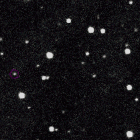 Detected only 20 hours before, the meteoroid designated 2008 TC3 burns up and explodes in Earth’s atmosphere, exploding 23 miles above the Sudanese desert. Estimated to be over ten feet in diameter prior to losing most of its mass to heating in the Earth’s atmosphere, 2008 TC3 is thought to have weighed in at approximately 80 tons; hundred of fragments with a total weight of a little over 20 pounds are recovered from the desert. This is the first Near-Earth Object detected prior to impact or destruction by the NASA-funded Spaceguard survey, though the time between detection, confirmation and arrival is less than a day.
Detected only 20 hours before, the meteoroid designated 2008 TC3 burns up and explodes in Earth’s atmosphere, exploding 23 miles above the Sudanese desert. Estimated to be over ten feet in diameter prior to losing most of its mass to heating in the Earth’s atmosphere, 2008 TC3 is thought to have weighed in at approximately 80 tons; hundred of fragments with a total weight of a little over 20 pounds are recovered from the desert. This is the first Near-Earth Object detected prior to impact or destruction by the NASA-funded Spaceguard survey, though the time between detection, confirmation and arrival is less than a day.
Mars in asteroid’s crosshairs
 Astronomers put the red planet on red alert after predicting 1-in-75 odds for an asteroid to collide with Mars on or near January 30th. The asteroid, discovered in November 2007, is on a trajectory that poses no threat to Earth but has better-than-usual odds of packing quite a wallop for Mars. The impact, if it does happen, could take place on the equator, near the Opportunity rover’s stomping (or, perhaps, roving) grounds, though NASA says it would pose no risk to Opportunity. A crater as large as Arizona’s Meteor Crater could be carved out of the Martian surface by any direct hit that does happen. Scientists prepare to watch the event with keen interest, as this event would be potentially cataclysmic if Earth was in danger, but provides a once-in-a-lifetime opportunity for observation on Mars.
Astronomers put the red planet on red alert after predicting 1-in-75 odds for an asteroid to collide with Mars on or near January 30th. The asteroid, discovered in November 2007, is on a trajectory that poses no threat to Earth but has better-than-usual odds of packing quite a wallop for Mars. The impact, if it does happen, could take place on the equator, near the Opportunity rover’s stomping (or, perhaps, roving) grounds, though NASA says it would pose no risk to Opportunity. A crater as large as Arizona’s Meteor Crater could be carved out of the Martian surface by any direct hit that does happen. Scientists prepare to watch the event with keen interest, as this event would be potentially cataclysmic if Earth was in danger, but provides a once-in-a-lifetime opportunity for observation on Mars.
2006 Robot Hall Of Fame inductees
 Five new robots, both fictional and real, are inducted into Carnegie Mellon University’s Robot Hall Of Fame. With C-3PO actor Anthony Daniels presenting the awards, the quintet of new inductees consists of:
Five new robots, both fictional and real, are inducted into Carnegie Mellon University’s Robot Hall Of Fame. With C-3PO actor Anthony Daniels presenting the awards, the quintet of new inductees consists of:
- Maria (1927, from Metropolis)
- Gort (1951, from The Day The Earth Stood Still)
- SCARA (1978, Yamanashi University – industrial small-component assembly robot)
- AIBO (1999, Sony – consumer grade robot dog with artificial intelligence)
- David (2001, from A.I.: Artificial Intelligence)
GOES-13 goes up
 NOAA’s GOES-13 Geostationary Operational Environmental Satellite is launched from Cape Canaveral into geosynchronous orbit to monitor weather patterns over the United States. It will be held in reserve until 2010, when it will be moved to the GOES-EAST position to replace GOES-12, which is suffering chronic attitude control thruster glitches. GOES-13 is yet another evolutionary step up in the GOES satellite hardware, but it will suffer its own share of hardware issues, including a series of inexplicable faults which will cause brief losses of weather coverage, and a later fault which disables infrared imaging capability. Some of these hardware failures will be attributed to micrometeoroid collisions.
NOAA’s GOES-13 Geostationary Operational Environmental Satellite is launched from Cape Canaveral into geosynchronous orbit to monitor weather patterns over the United States. It will be held in reserve until 2010, when it will be moved to the GOES-EAST position to replace GOES-12, which is suffering chronic attitude control thruster glitches. GOES-13 is yet another evolutionary step up in the GOES satellite hardware, but it will suffer its own share of hardware issues, including a series of inexplicable faults which will cause brief losses of weather coverage, and a later fault which disables infrared imaging capability. Some of these hardware failures will be attributed to micrometeoroid collisions.